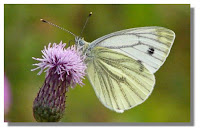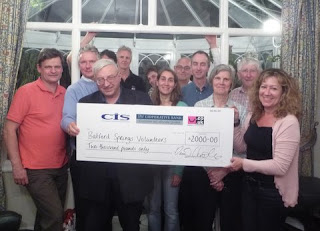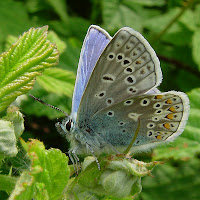Wednesday, 28 September 2011
Friday, 29 July 2011
Monday, 4 July 2011
Monday, 23 May 2011
Visit to Magog Downs by the Volunteers - 21st May 2011
On 21st May, the Batford Springs volunteers were welcomed by Lucy Evans to Magog Downs in Cambridgeshire, where we observed spectacular views across the open meadows and woodlands and also the wildlife that it supports. The Magog Downs committee have ambitious plans in recreating the flower-rich chalk grassland typical of a century ago.
The unusual name is thought to have come from an ancient legend. It is said that once two giants, Gog and Magog, fought each other to the death on the site, and their bodies created the hills.
The reserve, 163 hectares of low chalk hills, is privately owned and maintained, and is managed by the Magog Trust, which was set up in 1989. The cost of the upkeep is about £70k per annum, but it’s the scale of the conservation required that sets Batford Springs into perspective!
In terms of volunteers, Magog attracts approximately 5/6 per month so, whilst the list of priorities lengthens, there are restrictions on the time and cost of such activities; for example, six woods planted in 1990 and 1992 for commemorative purposes, that now house 24,000 native beech, hazel and hawthorn trees, will shortly need pruning and thinning. This is a massive undertaking, not only in time and money but also as a PR exercise, as many of the trees were donated by families in memory of loved ones. This is a huge undertaking, and only scratches the surface of the challenges faced by Lucy and her team.
The beauty of the downs is unquestionable, and some say you can see five counties from the top of the downs. The generous seating areas strategically placed around the downs allow the general public to enjoy the breathtaking views.
During our walk around the downs, we heard the ground-nesting skylark, and saw some typical downland plants, such as white helleborine, small scabious, ox-eye daisy, rockrose, clustered bellflower and cowslip. The meadows of wildflowers were busy doing their job in attracting an eclectic array of butterflies, including common blue, brown argus and small heath, and also the brightly coloured cinnabar moth.
The downs are enjoyed by families, individuals, dog walkers and kite flyers alike. Whilst the trust endeavours to plan fund-raising events on an annual basis, this together with the day-to-day maintenance of the downs, plus plans for the future, is a very substantial effort.
Thank you to Lucy for showing us around her ‘Manor’.
For anyone wishing a visit, please contact www.magogtrust.org.uk, or phone, 07796 471457Tuesday, 17 May 2011
The 10th Harpenden Scouts create a stir in the chalk streams
On the evening of the 16th May 2011, the 10th Harpenden Scouts joined us on the Reserve for one of their regular weekly meetings. No less than 31 Scouts and six leaders attended on-site to help with conservation activities. After a brief introduction to the Reserve, we set three tasks which they attacked with huge enthusiasm, achieving a great deal in little more than three quarters of an hour. They also sought to test those washing powder adverts that show dirt magically disappearing, at the same time managing to capture several gallons of stream water in their clothes to take home with them.
These sort of events are enjoyable for us as well as the groups that join us and represent another great example of our collaboration with local people. Of the four Volunteers on-site, Vicky joined in as always to the extent that she was wet up to her middle by the end, while Ian Thurman donned his chef's hat and cooked up a selection of hot dogs to perfection.. Virginia also joined us; she was a regular Volunteer a couple of years ago, but has since had some difficulty attending, so it was great to see her returning.
These sort of events are enjoyable for us as well as the groups that join us and represent another great example of our collaboration with local people. Of the four Volunteers on-site, Vicky joined in as always to the extent that she was wet up to her middle by the end, while Ian Thurman donned his chef's hat and cooked up a selection of hot dogs to perfection.. Virginia also joined us; she was a regular Volunteer a couple of years ago, but has since had some difficulty attending, so it was great to see her returning.
Friday, 13 May 2011
Voice Your Choice - Batford Springs wins funding
As you may have seen in the local press, Batford Springs Volunteers were successful with their application for a grant in the recent Voice Your Choice initiative. Harpenden residents were asked to vote on how £26,00 should be distributed amongst local organisations to help improve the quality of life in the town.
Batford Springs Volunteers submitted a proposal for the renovation of the central area of the Batford Springs Nature Reserve. 288 households voted for us and as a result we were awarded the full amount requested for our project, £2000. The cheque was presented to the group at their AGM (see photo).
The money will be used to renovate and revive that area of the Reserve between the footpath and the weir with new planting, sensitive reclamation of overgrown areas and the replacement of the ancient picnic tables.
Our thanks to everyone who supported the BSV proposal and also to Oliver Randell, who put in all the legwork on the application. Planning for the execution of the work is already well advanced.
Friday, 6 May 2011
Butterflies you may see on the Reserve
Here is a list of butterflies you may see on the Reserve. The list was actually created for the Nickey Line volunteers by Richard Harrington from the Rothamsted Institute, but he expects that the species will be similar to those on the Reserve.
BUTTERFLIES OF THE NICKEY LINE
CAST IN (VERY APPROXIMATE) ORDER OF APPEARANCE
Picture | Species | Flight time | Broods | Larval host plant | Winter stage |
Brimstone Gonepteryx rhamni (Pieridae) | Feb – Nov (peaks Apr, Aug) | 1 | Buckthorn Alder- buckthorn | Adult | |
Peacock Inachis io (Nymphalidae) | Mar – Oct (peak Aug) | 1 | Common nettle | Adult | |
Small Tortoiseshell Aglais urticae (Nymphalidae) | Mar – Oct (peak Aug) | 2 | Common nettle | Adult | |
Comma Polygonia c-album (Nymphalidae) | Mar – Nov (peaks Jul, Aug) | 2 | Currents Elms Hop Nettle Willows | Adult | |
Holly blue Celastrina argiolus (Nymphalidae) | Apr – Oct (peaks May, Aug) | 2 | Holly (spring) Ivy (summer) | Pupa | |
Speckled wood Pararge aegeria (Satyridae) | Apr – Oct (peak Aug) | 3 | Cock’s-foot False-brome Yorkshire-fog | Larva Pupa | |
Small white Pieris rapae (Pieridae) | Apr – Sep (peak Jul) | 2 | Brassicas | Pupa | |
 | Green-veined white Pieris napi (Pieridae) | Apr – Oct (peak Aug) | 2-3 | Charlock Cuckoo- flower Garlic-mustard | Pupa |
Picture | Species | Flight time | Broods | Host plant | Winter stage |
Large white Pieris brassicae (Pieridae) | Apr – Oct (peak Aug) | 2 | Brassicas | Pupa | |
Orange tip Anthocharis cardamines (Pieridae) | Apr – Jun (peak May) | 1 | Cuckoo-flower Garlic-mustard Cruciferae | Pupa | |
Common blue Polyommatus icarus (Lycaenidae) | May – Oct (peaks Jun, Aug) | 2 | Bird’s-foot-trefoil (Ant-attended) | Larva | |
Small copper Lycaena phlaeas (Lycaenidae) | May – Oct (peak Aug) | 2-3 | Common-sorrel Sheep’s-sorrel | Larva | |
Painted lady Cynthia cardui (Nymphalidae) | May – Oct (peak Aug) | Multiple | Thistles | Adult (Not in | |
Meadow brown Maniola jurtina (Satyridae) | (Jun – Sep) (peak Jul) | 1 | Bents Meadow-grasses | Larva | |
Large skipper Ochlodes venata (Hesperiidae) | Jun – Aug (peak Jul) | 1 | Cock’s-foot False-brome | Larva | |
Ringlet Aphantopus hyperantus (Satyridae) | Jun – Aug (peak Jul) | 1 | Cock’s-foot Common-couch etc. | Larva |
Picture | Species | Flight time | Broods | Host plant | Winter stage |
 | Marbled white Melanargia galathea (Satyridae) | Jun – Aug (peak Jul) | 1 | Red fescue Sheep’s- fescue | Larva |
Small skipper Thymelicus sylvestris (Hesperiidae) | Jun – Aug (peak Jul) | 1 | Yorkshire-fog Creeping-softgrass Timothy | Larva | |
Thymelicus lineola (Hesperiidae) | Jun – Aug (peak Jul) | 1 | Cock’s-foot Common-couch Creeping-softgrass Timothy | Egg | |
Gatekeeper Pyronia tithonus (Satyridae) | Jun – Sep (peak Aug) | 1 | Bents Fescues | Larva | |
Red Admiral Vanessa atalanta (Nymphalidae) | Jan – Dec (peak Sep) | Multiple | Common nettle | Adult (Not in | |
Clouded yellow Colias croceus (Pieridae) | Occasional migrant Jun – Oct (peak Sep) | Multiple | Clover | Adult (Not in |
Subscribe to:
Comments (Atom)






















